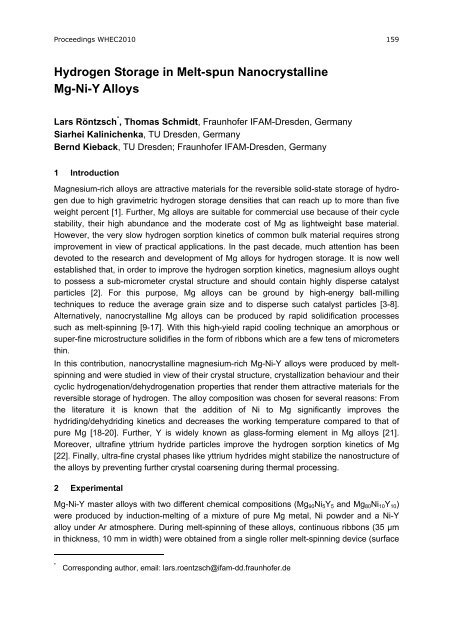Hydrogen Storage in Melt-spun Nanocrystalline Mg Ni Y Alloys
Hydrogen Storage in Melt-spun Nanocrystalline Mg Ni Y Alloys
Hydrogen Storage in Melt-spun Nanocrystalline Mg Ni Y Alloys
Create successful ePaper yourself
Turn your PDF publications into a flip-book with our unique Google optimized e-Paper software.
Proceed<strong>in</strong>gs WHEC2010 159<br />
<strong>Hydrogen</strong> <strong>Storage</strong> <strong>in</strong> <strong>Melt</strong>-<strong>spun</strong> Nanocrystall<strong>in</strong>e<br />
<strong>Mg</strong>-<strong>Ni</strong>-Y <strong>Alloys</strong><br />
Lars Röntzsch * , Thomas Schmidt, Fraunhofer IFAM-Dresden, Germany<br />
Siarhei Kal<strong>in</strong>ichenka, TU Dresden, Germany<br />
Bernd Kieback, TU Dresden; Fraunhofer IFAM-Dresden, Germany<br />
1 Introduction<br />
Magnesium-rich alloys are attractive materials for the reversible solid-state storage of hydrogen<br />
due to high gravimetric hydrogen storage densities that can reach up to more than five<br />
weight percent [1]. Further, <strong>Mg</strong> alloys are suitable for commercial use because of their cycle<br />
stability, their high abundance and the moderate cost of <strong>Mg</strong> as lightweight base material.<br />
However, the very slow hydrogen sorption k<strong>in</strong>etics of common bulk material requires strong<br />
improvement <strong>in</strong> view of practical applications. In the past decade, much attention has been<br />
devoted to the research and development of <strong>Mg</strong> alloys for hydrogen storage. It is now well<br />
established that, <strong>in</strong> order to improve the hydrogen sorption k<strong>in</strong>etics, magnesium alloys ought<br />
to possess a sub-micrometer crystal structure and should conta<strong>in</strong> highly disperse catalyst<br />
particles [2]. For this purpose, <strong>Mg</strong> alloys can be ground by high-energy ball-mill<strong>in</strong>g<br />
techniques to reduce the average gra<strong>in</strong> size and to disperse such catalyst particles [3-8].<br />
Alternatively, nanocrystall<strong>in</strong>e <strong>Mg</strong> alloys can be produced by rapid solidification processes<br />
such as melt-sp<strong>in</strong>n<strong>in</strong>g [9-17]. With this high-yield rapid cool<strong>in</strong>g technique an amorphous or<br />
super-f<strong>in</strong>e microstructure solidifies <strong>in</strong> the form of ribbons which are a few tens of micrometers<br />
th<strong>in</strong>.<br />
In this contribution, nanocrystall<strong>in</strong>e magnesium-rich <strong>Mg</strong>-<strong>Ni</strong>-Y alloys were produced by meltsp<strong>in</strong>n<strong>in</strong>g<br />
and were studied <strong>in</strong> view of their crystal structure, crystallization behaviour and their<br />
cyclic hydrogenation/dehydrogenation properties that render them attractive materials for the<br />
reversible storage of hydrogen. The alloy composition was chosen for several reasons: From<br />
the literature it is known that the addition of <strong>Ni</strong> to <strong>Mg</strong> significantly improves the<br />
hydrid<strong>in</strong>g/dehydrid<strong>in</strong>g k<strong>in</strong>etics and decreases the work<strong>in</strong>g temperature compared to that of<br />
pure <strong>Mg</strong> [18-20]. Further, Y is widely known as glass-form<strong>in</strong>g element <strong>in</strong> <strong>Mg</strong> alloys [21].<br />
Moreover, ultraf<strong>in</strong>e yttrium hydride particles improve the hydrogen sorption k<strong>in</strong>etics of <strong>Mg</strong><br />
[22]. F<strong>in</strong>ally, ultra-f<strong>in</strong>e crystal phases like yttrium hydrides might stabilize the nanostructure of<br />
the alloys by prevent<strong>in</strong>g further crystal coarsen<strong>in</strong>g dur<strong>in</strong>g thermal process<strong>in</strong>g.<br />
2 Experimental<br />
<strong>Mg</strong>-<strong>Ni</strong>-Y master alloys with two different chemical compositions (<strong>Mg</strong> 90 <strong>Ni</strong> 5 Y 5 and <strong>Mg</strong> 80 <strong>Ni</strong> 10 Y 10 )<br />
were produced by <strong>in</strong>duction-melt<strong>in</strong>g of a mixture of pure <strong>Mg</strong> metal, <strong>Ni</strong> powder and a <strong>Ni</strong>-Y<br />
alloy under Ar atmosphere. Dur<strong>in</strong>g melt-sp<strong>in</strong>n<strong>in</strong>g of these alloys, cont<strong>in</strong>uous ribbons (35 μm<br />
<strong>in</strong> thickness, 10 mm <strong>in</strong> width) were obta<strong>in</strong>ed from a s<strong>in</strong>gle roller melt-sp<strong>in</strong>n<strong>in</strong>g device (surface<br />
*<br />
Correspond<strong>in</strong>g author, email: lars.roentzsch@ifam-dd.fraunhofer.de
















